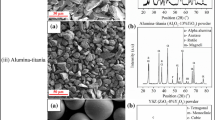Abstract
The addition by vacuum infiltration of small quantities of a polymer has been found to increase significantly the ability of a plasma-sprayed coating to dissipate vibratory energy at temperatures in the glassy-rubbery transition range of the polymer. As vitreous enamels and glasses undergo a glassy transition, but at much higher temperatures, the addition of a small amount of glass to a ceramic has the potential of providing high damping at such temperatures. Mixtures of yttria-stabilized zirconia (YSZ) and a glass frit were plasma sprayed on specimens with bond coats. Measures of system response (resonant frequencies and loss factors) were extracted from frequency responses to excitations of cantilever beam specimens over a range of excitation amplitudes. Comparisons of values determined before and after coating were used to determine the damping properties of the coatings alone as functions of strain, at temperatures of special interest. Emphasis was given to identifying the lowest level of glass giving significantly more damping than that of the plasma-sprayed ceramic alone. Coatings with weight fractions of 5, 2, 1, ½, and 0% glass were tested. The inclusion of glass at all weight fractions considered was found to yield significant increases in both the stiffness and dissipation of the coatings.













Similar content being viewed by others
References
S. Patsias, Composite Damping Ceramic Coatings by Polymer Integration, Key Eng. Mater., 2006, 319, p 181–188
P.J. Torvik, R. Willson, and J. Hansel, Influence of a Viscoelastic Surface Infiltrate on the Damping Properties of Plasma Sprayed Alumina Coatings, Part I: Room Temperature, Proc. Mater. Sci. and Tech. 2007 Conf. and Exhibition (MS&T 2007), Am. Ceram. Soc., 2007, p 139–150
P. Torvik, R. Willson, J. Hansel, and J. Henderson, Influence of a Viscoelastic Surface Infiltrate on the Damping Properties of Plasma Sprayed Alumina Coatings. Part II: Effects of Elevated Temperature and Static Strain, Proc. Mater. Sci. and Tech. 2007 Conf. and Exhibition (MS&T 2007), Am. Ceram. Soc., 2007, p 151–162
P.J. Torvik and J. Hansel, Mechanical Properties of a Ceramic Coating with VEM Infiltration, J. Mater. Sci. Eng., 2009, 131(3), p 031003-1–9
W.D. Brentnall, A.R. Stetson, A.G. Metcalfe, and A.D. Nashif, Enamels for Engine Structural Damping, AFWAL-TR-83-4110, Materials Laboratory, WPAFB, 1983
J.P. Henderson, A.D. Nashif, J.E. Hansel, and R.M. Willson, Enhancing the Passive Damping of Plasma Sprayed Ceramic Coatings, Advanced Ceramic Coatings and Interfaces IV, Vol 30(3), D. Singh and D. Salem, Ed., John Wiley, Hoboken, NJ, 2009, p 9–20
“Standard Test Method for Measuring Vibration Damping Properties of Materials,” ASTM E 756-05, ASTM International, 2005
N. Tassini, K. Lambrinou, I. Mircea, S. Patsias, O. Van der Biest, and R. Stanway, Comparison of the Damping and Stiffness Properties of 8 wt% Yttria Stabilized Zirconia Ceramic Coating Deposited by the APS and EB-PVD Techniques, Smart Structures and Materials 2005; Damping and Isolation, Proc. SPIE, K.-L. Wang, Ed., Vol. 5760, SPIE, 2005, p 109–117
P.J. Torvik, Determination of Mechanical Properties of Non-linear Coatings from Measurements with Coated Beams, Int. J. Solids Struct., 2009, 46(5), p 1066–1077
P.J. Torvik, A Note on the Estimation of Non-linear System Damping, J. Appl. Mech. ASME, 2003, 70(3), p 449–450
P.J. Torvik, A Slip Damping Model for Plasma Sprayed Ceramics, J. Appl. Mech., 2009, 76(6), p 061018-1–8
P.J. Torvik, A Survey of the Damping Properties of Hard Coatings for Turbine Engine Blades, Integration of Machinery Failure Prevention Technologies into System Health Management, Soc. Machine Failure Prevention Tech., 2007, p 485–506
Acknowledgments
The authors gratefully acknowledge the contributions of Mr. Ahid Nashif for the development of these coatings and of Mr. Jason Hansel, Universal Technology Corporation, for the performance of tests using the resources of the Turbine Engine Fatigue Facility, Wright-Patterson AFB, OH. Support for this study was provided by Army SBIR Phase II Contract No. W911W6-07-C-0043 “Advanced Damping Technologies for Small Turbine Engines,” with Anastasia Kozup, USA, AMC, as the technical point of contact. The prime contractor, APS Materials, Inc., Dayton, OH, provided all test materials and permission to publish these results.
Author information
Authors and Affiliations
Corresponding author
Rights and permissions
About this article
Cite this article
Torvik, P.J., Henderson, J.P. Influence of Glass Content on Damping Properties of Plasma-Sprayed Mixtures of Zirconia and Glass. J. of Materi Eng and Perform 21, 1405–1415 (2012). https://doi.org/10.1007/s11665-011-0011-4
Received:
Revised:
Published:
Issue Date:
DOI: https://doi.org/10.1007/s11665-011-0011-4




